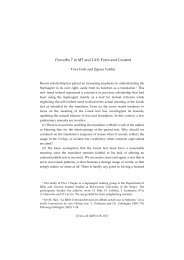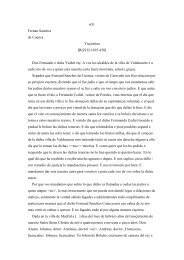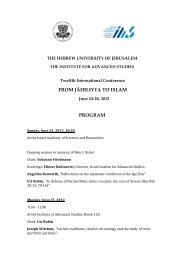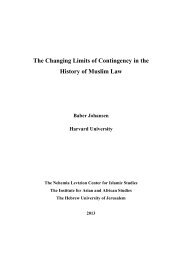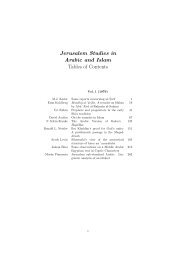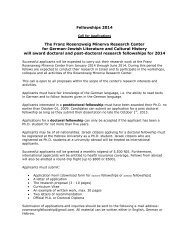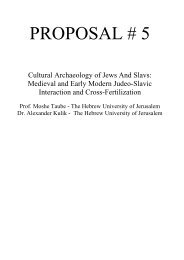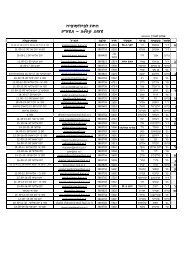THE BOOK OF EZEKIEL Moshe H. Goshen-Gottstein Shemaryahu ...
THE BOOK OF EZEKIEL Moshe H. Goshen-Gottstein Shemaryahu ...
THE BOOK OF EZEKIEL Moshe H. Goshen-Gottstein Shemaryahu ...
You also want an ePaper? Increase the reach of your titles
YUMPU automatically turns print PDFs into web optimized ePapers that Google loves.
III. Apparatus I: The Versions<br />
mentioned in the previous section, are recorded in the apparatus with qualifying remarks,<br />
if any, in the notes (see below). 27 Two important points must be born in mind: (1) retroversion<br />
of a translation variant is always conjectural; (2) the presumed existence of a variant in<br />
a version does not imply that it is preferable over the MT. 28<br />
37. (c) Differences between x and a version that can be attributed to the exegetical nature<br />
of a translation. Although this may be the most likely explanation, the editors do not refrain<br />
from recording variants that may reflect a reading for which a suitable retroversion into<br />
Hebrew cannot easily be suggested.<br />
38. Notations in apparatuses I–IV are non-verbal (cf. below §53), and pertain only to data<br />
that reflect or may reflect variants. They are distinguished from the explanatory notes (cf.<br />
below, §55), which contain all verbalized reflections and suggestions, intended to present<br />
pertinent facts, at times to discount the possibility that a retroversion reflects an actual<br />
variant reading, or present considerations which may account for the variation.<br />
39. Symbols such as > (minus), or differences of a grammatical nature, especially those<br />
marked ‘pers’, ‘num’, ‘pron’, etc., are self-explanatory. Occasionally, however, such differences<br />
are dealt with in an explanatory note (for example, 8:14, n. 2; 21:24, n. 1).<br />
40. Retroversions suggested in the explanatory notes are recorded in order of probability.<br />
Unequivocal retroversions are recorded without any comments. ‘Perhaps’ (p) suggests a<br />
possible variant or editorial explanation, with a degree of doubt; ‘hardly’ indicates that there<br />
is practically no basis for the proposed variant; ‘not’ negates proposed variants. 29 The notes<br />
also characterize variants as items in the ‘index of phenomena’, namely, types of recurring<br />
textual variants, indicated by mostly self-explanatory abbreviations such as ‘exeg’, ‘struct’,<br />
‘etym’, etc. 30 Syntactic or other difficulties in the Hebrew text which may have posed<br />
difficulties for translators are marked in the notes by the word “note problem x” (cf., for<br />
example, 3:6; 6:11; 39:11). Notes are given in apparatuses II–IV or the Masora notations<br />
only when necessary.<br />
41. Readings from the versions are quoted according to the sequence of the MT, as are<br />
readings from sources in the other apparatuses. A lemma is separated from the previous one<br />
by the marker (, except at the beginning of a verse, and separated from the translational<br />
reading by a square bracket, for example, ux`d]. Verse numbers are indicated in bold Arabic<br />
numerals. 31 References pertaining to two or more verses or to a string of words precede<br />
references to a single verse or to a smaller stretch of words; strings of words continuing<br />
Bible, The Hebrew University, 1982] 188; E. Tov, TCHB, 333–334. A useful tool for the evaluation<br />
of minus readings in LXX is F. Polak and G. Marquis, A Classified Index of the Minuses of the<br />
Septuagint (CATSS Basic Tools 4; Stellenbosch: Print24.com, 2002).<br />
27 Different types of textual phenomena that may underlie an apparent textual variance are often not<br />
specified, such as similarity of sound and form (including letters in the ancient Hebrew script),<br />
ligatures, scriptio continua, enclitic mem etc.<br />
28 For a detailed discussion of the issue of retroversion cf. Tov, TCU, 57–89.<br />
29 At times more than one counter-proposal may be adduced (e.g., 16:54, n. 1; 20:40, n. 4); cf. also<br />
below §52.<br />
30 See the table of abbreviations below, §55.<br />
31 Abbreviations of titles of biblical books follow SBL conventions. Differences in the numbering of<br />
verses between this edition and others are negligible.<br />
xix



